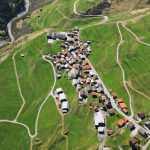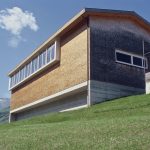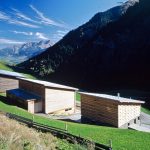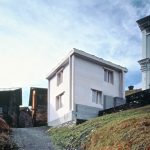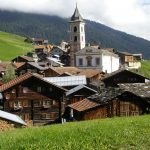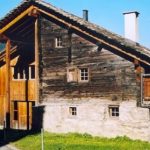Vrin, Graubünden, Switzerland
The municipality Vrin is located at an altitude of 1,450 m and has 250 inhabitants. The communal surface comprises 7,123 ha, 2,600 ha thereof are alpine areas, 478 ha are covered with forests, 300 ha are meadows and only 10 ha remain for settlement purposes.
The remote mountain village is still an active farming community with unchanging population numbers and an exemplary development process. The latter dates back to a decision in 1979, when the exodus of many Graubündner mountain villages was in full swing and the population numbers in Vrin, too, fell from 450 in 1950 to approx. 270. Back then, the Pro Raetia – a society for the promotion of local affairs in regard to culture, society and economy – established the foundation “Pro Vrin”. Objective was the preservation of the cultural-historical and architectural substance and the improvement of housing quality.
In 1982, the process of merging properties has been initiated, enabling a future-orientated farming industry. At the same time, the road network was extended and measures for the processing and marketing for local products were implemented. These include the foundation of a coop operating a slaughter house and a butcher’s shop, the direct marketing of the Bündner dried meat and the construction of stables, personnel quarters and a dairy farm for cheese production and the marketing of dairy products in a small shop near a highly frequented hiking trail.
New impulses were set on a political level, too. The extension of a reservoir in the Greina High Plain was canceled; instead the area was included as a protectorate in the Federal List of Landscapes and Natural Monuments of Switzerland. During the past ten years, 28 ha of protective forest was planted with the aid of school children and local societies, an example for the endeavors to strengthen environment-friendly forestry.
It was a time where a new awareness for resources and potentials was created. Apart from the untouched nature and the cultural landscape created during hundreds years of work, the citizens of Vrin became increasingly aware of their impressive buildings, which needed to be preserved and developed further. Most of the heart of today’s village stems from the second half of the 18th century. Residential buildings and stables, almost all timber block constructions, reflect the close links to agriculture.
In addition to the allocation of construction zones and the acquisition of properties through the municipality, important guidelines for constructions were set forth. Timber is the one common component in all building structures. The use of local materials and the commissioning of regional businesses generate a high level of value-added. Communal building projects like the Stiva da Morts (a place where wakes are being held) and the community house reflect the philosophy.
In addition to a school, there is a bakery and a small food store, where consumers participate in the profit, motivating them to do their shopping in the village. The societies and associations organize lunch and other services for senior citizens.
Vrin is characterized through its numerous, interlinked projects, contributing markedly to the preservation of the cultural-historical and architectural substance and the improvement of the housing quality. The high quality of architecture is impressive, so is the use of local material, the measures for direct marketing, the multi-functional community hall with its innovative wood details and the construction of a room for wakes in the centre of the village, all examples for the strong sense of community.
Evaluated: 2010

